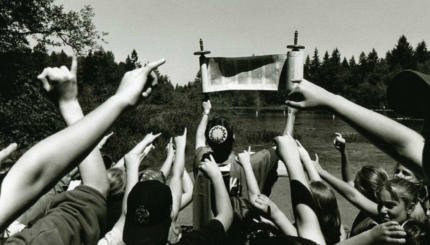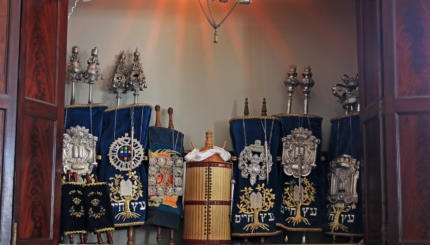Your d’var Torah will almost inevitably fall into some rather specific categories or combinations of a couple of them.
1. The Microscope
From close up you look at very small fragments of a text in great detail and hope that as you magnify the specks you will discover whole worlds within them. You have to be sure to pick up your specks with care, but you will know that you have some nice ones if the commentators are as interested in them as you are. If they aren’t, chances are you should forget it, too.
Example: Take the first word of Genesis or, better yet, the first word of Leviticus (which you’ll need more because the story line is not as interesting), and describe how a series of biblical commentators have treated that word, what problem it represented for them, and what generalizations can be made about their resolutions.
2. The Airplane
Observe the text from a distance, survey the panorama, take note of interesting details, and then as you descend make observations on why the trip was worthwhile in the first place and how to appropriate what you have just observed for your more earthbound existence. The Airplane is especially suitable for those Torah readings that deal with ritual details at great length.

Help us keep Jewish knowledge accessible to millions of people around the world.
Your donation to My Jewish Learning fuels endless journeys of Jewish discovery. With your help, My Jewish Learning can continue to provide nonstop opportunities for learning, connection and growth.
Example: After describing the architecture of the Mishkan [the Tabernacle that served as the Israelite’s place of worship during their wandering in the wilderness] and its role in the lives of people, you might want to discuss the role of minutiae in the building of a religious life. As the French say, God is to be found in the details.
Or: A discussion of the Mishkan often suggests an evaluation of the difference between a Judaism that is fixed in one place, Jerusalem and the Temple, and the portable Judaism of the Mishkan that can be carried about wherever we go.
3. The Diving Board
This one begins with an idea from the text, takes a big jump, and carries it into another issue of greater interest to you.
Example: If the text deals with the furniture of the Mishkan, you can talk about the history of the artifacts used in the synagogue. Or if the text devotes a lot of attention to the dress of the priest, you can discuss Jewish traditions about dress and articles of clothing, the significance of the tallit [prayer shawl], the kippah [yarmulke], the special hats Jews were required to wear in the Middle Ages, or the self-imposed restrictions that Jewish communities once placed on fancy clothing.
If the text contains long lists of names, you can present a history of the origins of some characteristic Jewish names, including the names of some of the people who will be present when you speak.
If you are new at giving divrei Torah, the thematic approaches represented by the Airplane and the Diving Board may be the easiest for you to handle. Unless you are basing yourself on a traditional commentator, stay away from forms like Microscope or Puzzle (see below) until you know enough Hebrew to be able to distinguish between a real nuance in the text and a mere idiosyncrasy of translation.
4. The Snuff Box
This is a less respectable version of the Diving Board. A visiting maggid, or preacher, used to go from one community to the next. Just before he began his only sermon, his snuff box would drop out of sight. “Where is it?” he would ask loudly. “It has vanished, swallowed up the way the earth swallowed up Korah and his company … which reminds me of an important thought about Korah.”
Inventing a non-existent relationship between the text and a talk you would like to give is a technique generated by desperation. If you have just looked at the parashah (the weekly Torah reading) for the first time the morning you have to speak and you have discovered that there isn’t even any good commentary on the text, then you are in deep trouble and may have to bail yourself out. But even then, the Snuff Box approach is definitely shabby. When you are finished speaking, your listeners have the right to expect that they will know at least some small new thing about the Torah they didn’t know before. The Snuff Box rarely provides that. You may be sufficiently stuck that you have no alternative, but this is not a method of which you should be particularly proud.
Occasionally you will have an idea that can legitimately be attached to a number of texts. If, for example, you want to talk about the significance of miracles and have a talk in mind, you can probably hang it on several parashot (plural of parashah) where miracles are found. Such a d’var Torah should not be considered a Snuff Box.
5. The Biblical Personality
Dealing with the narrative portions of the Torah, it is possible to analyze the characters of biblical figures and the events of their lives in ways that will shed some light on our own. Some of the standard subjects in this category include Jacob and Esau or Joseph and his brothers and the problems of sibling rivalry and preferred children, or Sarah and Hagar and the jealous wife. Louis Ginzberg’s Legends of the Jews can often be of great assistance in supplementing your sense of a biblical character. Originally published in six volumes, it is also condensed into one thick paperback [called Legends of the Bible]. Certain People of the Book by Maurice Samuel can also be helpful in this area.
6. The Puzzle
People love to solve puzzles. If there is classic form for the d’var Torah, this is it. You present several apparently discrepant facts or texts and then explain how the contradictions aren’t contradictions at all, but instead point to a deeper meaning that was not obvious at first.
Example: Light was created on the first day of creation, while the sun and the moon were not created until the fourth. Where did the original light come from? Rashi has an answer; in fact, he has several answers. So does contemporary physics. Can one derive an authentic Jewish response to the creationism controversy from these texts?
Or: Why is the story of the mission to find Isaac a wife repeated four times, each time with slight differences?
Or: The Torah tells us that we are not permitted to eat leaven on Passover because the people of Israel did not have enough time to allow their bread to rise as they hurried out of Egypt. But they did have leaven in their bread. Why should we not have been told simply to bake our leavened Passover bread quickly before it has time to rise? That would have been a closer approximation to this important incident in our history.
Or: Consider the riddle of the red heifer (Numbers 19), whose ashes are used to purify the people who are impure but make impure the pure who do the purifying. Attempts to solve this one or just shed some light on it have been the subject of innumerable divrei Torah throughout the ages.
Nehama Leibowitz, in her volumes compiled as “Studies in the Weekly Sidra,” is particularly skillful in the creation and resolution of such puzzles. She never lets her readers off easily, so they still have quite a bit of work to do even after reading her material. But she brings a great deal of interesting rabbinic literature, that is otherwise not available in English, to bear on the questions she considers.
Classical Jewish literature loved the “Puzzle” technique, which in its more elaborate form is known as pilpul (literally pepper–i.e., a sharp performance). These days, except in very specialized communities, one has to be careful not to get as carried away by it as our forefathers sometimes were. The number of contradictory facts that a contemporary Jew–even a smart one–can carry is rather limited. Don’t build too clever a structure or it will fall apart and you will lose everyone.
7. The Historian
Historical insights can sometimes open up a text in an exciting way. Even if you don’t draw any deep morals, people are frequently delighted and enriched when they see a text in its historical setting.
Example: Verse 1:9 in Song of Songs says, “My love, you are like a mare among Pharaoh’s chariots.” Buckets of ink have been used to describe the literary significance of that particular image, but Marvin Pope’s commentary in the Anchor Bible deciphers this verse with case. In the ancient Middle East a particularly effective way to disrupt your enemy’s chariot charge was to release a mare in heat to run among the stallions pulling the chariots. This would throw the horses into pandemonium. The verse thus says simply that his beloved is profoundly exciting to him. Such an explanation may not carry a lot of spiritual weight, but people do like to learn such tidbits.
A word of caution: Don’t get too carried away with the idea that the Bible is a history book. It is also a history book, but it is not only or even primarily that. Instead, it is a religious book that wants to tell us about the relationship of God to the people Israel. You should never let that fact out of your head as you prepare your d’var Torah.
Reprinted with permission from The Kosher Pig and Other Curiosities of Modern Jewish Life (Torah Aura Productions). The essay from which this article was excerpted, “How to Give a D’var Torah,” originally appeared in New Traditions, published by the National Havurah Committee.
Torah
Pronunced: TORE-uh, Origin: Hebrew, the Five Books of Moses.

Help us keep Jewish knowledge accessible to millions of people around the world.
Your donation to My Jewish Learning fuels endless journeys of Jewish discovery. With your help, My Jewish Learning can continue to provide nonstop opportunities for learning, connection and growth.



